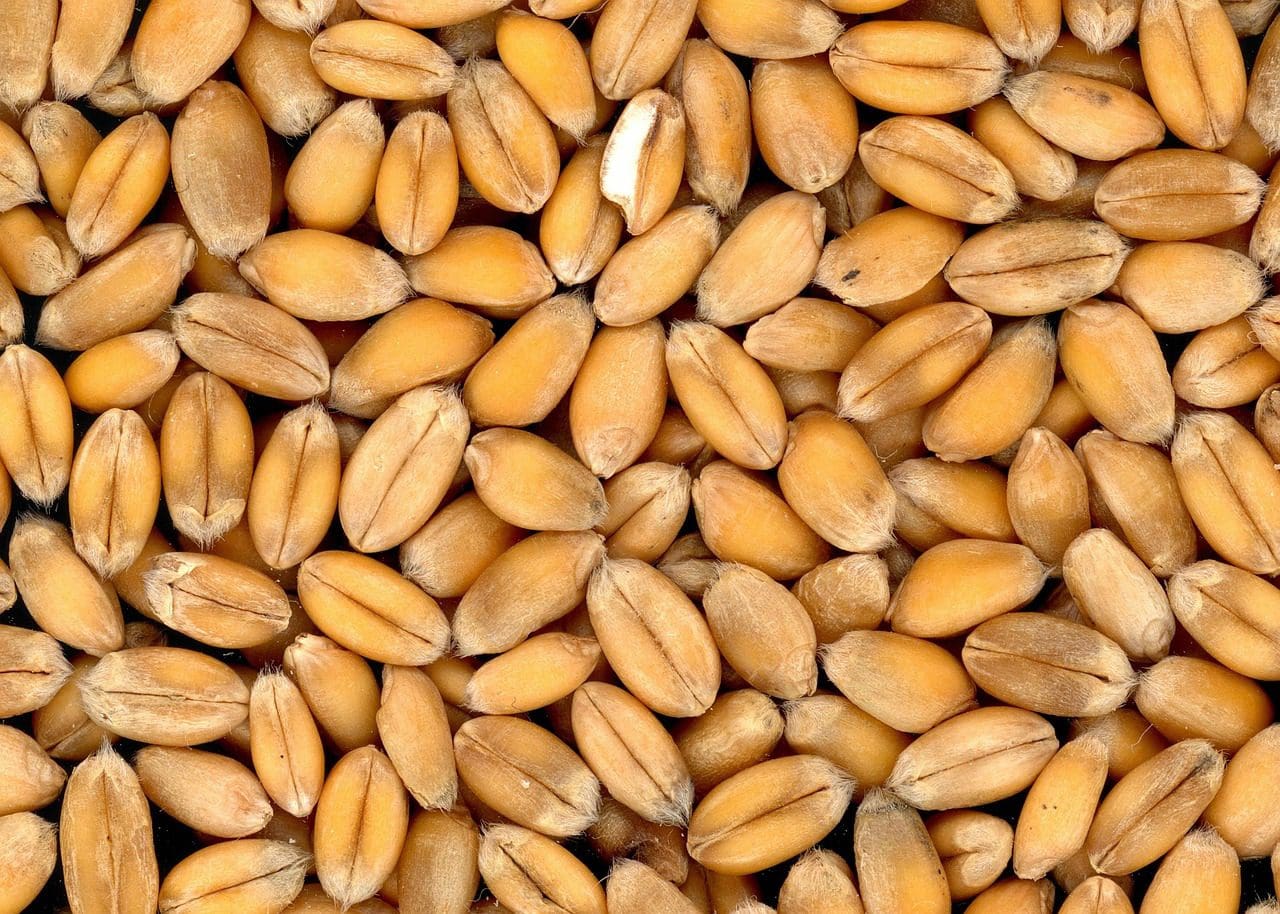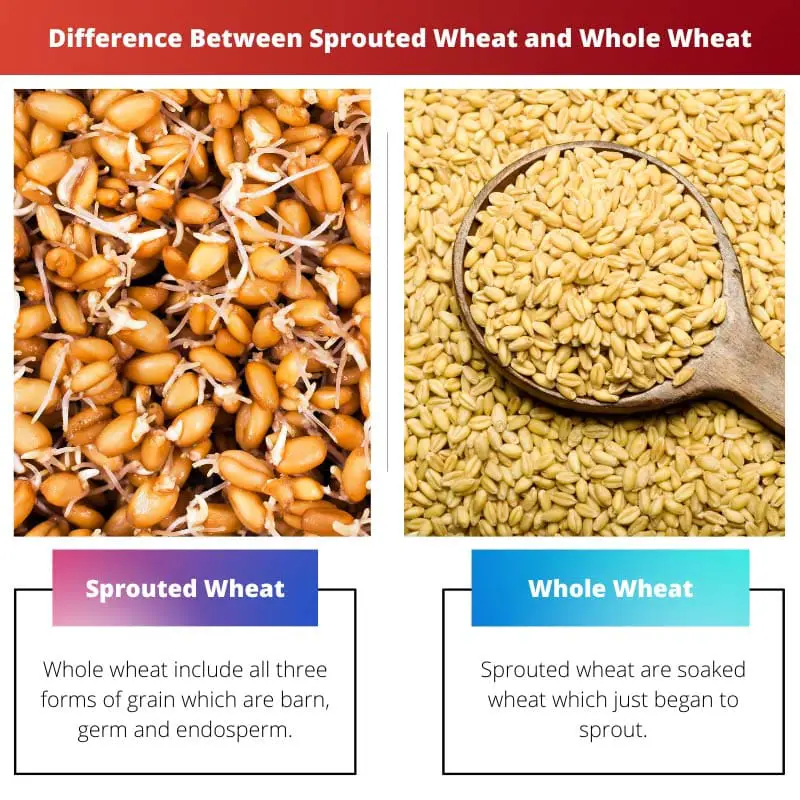Consumption of wheat plays a major role in our daily diets. It contains a lot of fibres , protein and other nutrients.
Knowing the difference between whole wheat and sprouted wheat can majorly vary the amount of nutrient consumption in our meals.
Key Takeaways
- Sprouted wheat is made from whole wheat grains allowed to germinate, while whole wheat is made from the wheat kernel, including the bran, germ, and endosperm.
- Sprouted wheat is easier to digest due to the breakdown of complex carbohydrates during germination, while whole wheat contains more intact carbohydrates.
- Sprouted and whole wheat is more nutritious than refined grains, but sprouted wheat may have increased levels of vitamins and minerals due to the germination process.
Whole Wheat vs Sprouted Wheat
In terms of nutritional benefits, sprouted wheat flour is considered to be a superior choice, as it contains higher levels of certain nutrients and may be digestible. Whole wheat flour is a good source of nutrients and is widely available at a lower cost, making it more practical.

Whole wheat refers to entire grains of wheat that consist of a fibrous outer layer. Whole wheat flour and it other associated products have : unique bran, germ, and endosperm.
Bran is the fibrous outer layer of the kernel that’s rich in B vitamins and different minerals, at the same time as germ is wealthy in a variety of vitamins, consisting of vitamin E, B nutrients, antioxidants, and healthful fats.
The endosperm is the most important part of the kernel, containing starchy carbs. Refined wheat or white flours comprise simplest the endosperm.
Sprouted wheat refers to the wheat grains that have been soaked foe long enough that they just began to sprout (show roots).
The procedure of sprouting them is simple , we have to look for the right temperature and environment and soak them in sufficient water.
It is easy to do it anywhere , all you need is a vented jar.
It is important to understand the fact that raw sprouts are not enough healthy as they say because the moist environment in which they were soaked can promote bacterial growth.
Sprouted wheat is can be used in different forms as flour , bread , cakes , buns , muffins , etc.
Comparison Table
| Parameters of Comparison | Whole Wheat | Sprouted Wheat |
|---|---|---|
| Definition | Whole wheat include all three forms of grain which are barn, germ and endosperm. | Sprouted wheat are soaked wheat which just began to sprout |
| Digestive power | They are difficult to digest than sprouted wheat | They are easier to digest. |
| Appearance | They have a finer texture . | They have an earthy taste and rough texture. |
| Nutrition | The contain less nutrients compared to sprouted wheat. | They are rich in nutrients. |
| Uses | Can be used in making pancakes , muffins, bread recipes. | Sprouted wheat is used in salads. |
What is Whole Wheat?
Whole wheat by definition is a wheat grain that consist of three parts : bran , germ and endosperm making them rich in nutrients than refined wheat.
Bran: This is the solid fibrous outer layer of the grain, which includes fibre, minerals, and antioxidants.
Germ: The germ is the nutrient-rich middle of the grain, which incorporates vitamins, minerals, and beneficial plant compounds, as well as small amounts of carbs, fat, and protein.
Endosperm: This is the biggest a part of the grain and in the main made up of carbs and protein.
When refining the whole wheat, the bran and germ , their many vitamins are removed.
The method leaves simplest the endosperm at the back of, that is why whole wheat is greater nutrient-wealthy than other refined wheat.
Nowadays most wheat flour products that are sold are made of roller milled flour with germ and barn mixed in unnatural proportions.
When came of grain products, whole wheat products are consumed more because they are more nutritious.
They contain healthy fibre, fats and nutrients. Whole wheat is associated with reducing the risk of various chronic conditions like diabetes , cancer and heart diseases.

What is Sprouted Wheat?
Sprouted wheat refers to the wheat grains that have been soaked long enough and have been sprouted .Procedure of sprouting wheat is easy , just soak a handful of wheat grains in muslin cloth.
As soon as the grains are germinated , valuable enzymes are activated and once eaten provide great benefits to a person.
They are rich in nutrients which helps the body to boost it’s metabolism, also helps in blood cleansing . These sprouts if stored in refrigerator can be consumed within 3 days.
Sprouting makes wheat seeds include 300% extra proteins chargeable for enhancing metabolism of our body , increasing energy, and maintaining blood sugar degrees stable.
Sprouted wheat and whole wheat have same nutrients just their quantities vary.
Only three days of spouting growth the density of vitamins dramatically: the content material of diet E will increase 300%, of vitamin C – six hundred%, and the content material of vitamin B becomes one thousand% better.
The content of diet B17 known for its prevention of most cancers is 100% better than in un sprouted seeds.
Originally, wheat is rich in carbohydrate and causes immoderate mucus, which could have unpleasant outcomes including persistent cough, crusty eyes, continuously stuffy nose, and awful breath.
In the procedure of sprouting, carbohydrates are transformed to natural sugar, lowering the amount of mucus being formed .

Main Differences Between Sprouted Wheat and Whole Wheat
- Whole wheat is raw wheat that include three forms : bran, germ and endosperm , whereas sprouted wheat are wheat grains that have been soaked and just began to show roots.
- Whole wheat is difficult to digest as compared to sprouted wheat grains.
- Sprouting wheat enhances the nutrition content present it, whereas if we consume whole wheat it contains less amount of nutrients compared to sprouted wheat.
- Whole wheat have finer texture , whereas sprouted wheat have rough texture.
- Whole wheat can be used in making cakes , muffins , cookies and other baking recipes too ,whereas sprouted wheat is used in salads.

- https://onlinelibrary.wiley.com/doi/abs/10.1111/j.1365-2621.1976.tb00709_41_3.x
- https://www.sciencedirect.com/science/article/pii/S0308814609008164
